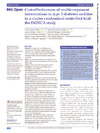Identificador persistente para citar o vincular este elemento:
https://accedacris.ulpgc.es/jspui/handle/10553/114516
| Título: | Cost-effectiveness of multicomponent interventions in type 2 diabetes mellitus in a cluster randomised controlled trial: the INDICA study | Autores/as: | García-Pérez, Lidia Ramallo Fariña, Yolanda Vallejo Torres, Laura Rodríguez Rodríguez, Leticia González Pacheco, Himar Santos Hernández, Beatriz García Bello, Miguel Angel Wägner, Anna Maria Claudia Carmona, Montserrat Serrano Aguilar, Pedro G. |
Clasificación UNESCO: | 531207 Sanidad | Palabras clave: | Diabetes and endocrinology Health economics Health informatics Primary care Quality in health care |
Fecha de publicación: | 2022 | Proyectos: | ADE10/00032 PI16/00769 |
Publicación seriada: | BMJ Open | Resumen: | OBJECTIVE: To analyse the cost-effectiveness of multicomponent interventions designed to improve outcomes in type 2 diabetes mellitus (T2DM) in primary care in the Canary Islands, Spain, within the INDICA randomised clinical trial, from the public health system perspective. DESIGN: An economic evaluation was conducted for the within-trial period (2 years) comparing the four arms of the INDICA study. SETTING: Primary care in the Canary Islands, Spain. PARTICIPANTS: 2334 patients with T2DM without complications were included. INTERVENTIONS: Interventions for patients (PTI), for primary care professionals (PFI), for both (combined intervention arm for patients and professionals, CBI) and usual care (UC) as a control group. OUTCOMES: The main outcome was the incremental cost per quality-adjusted life-years (QALY). Only the intervention and the healthcare costs were included. ANALYSIS: Multilevel models were used to estimate results, and to measure the size and significance of incremental changes. Missed values were treated by means of multiple imputations procedure. RESULTS: There were no differences between arms in terms of costs (p=0.093), while some differences were observed in terms of QALYs after 2 years of follow-up (p=0.028). PFI and CBI arms were dominated by the other two arms, PTI and UC. The differences between the PTI and the UC arms were very small in terms of QALYs, but significant in terms of healthcare costs (p=0.045). The total cost of the PTI arm (€2571, 95% CI €2317 to €2826) was lower than the cost in the UC arm (€2750, 95% CI €2506 to €2995), but this difference did not reach statistical significance. Base case estimates of the incremental cost per QALY indicate that the PTI strategy was the cost-effective option. CONCLUSIONS: The INDICA intervention designed for patients with T2DM and families is likely to be cost-effective from the public healthcare perspective. A cost-effectiveness model should explore this in the long term. TRIAL REGISTRATION NUMBER: NCT01657227. | URI: | https://accedacris.ulpgc.es/handle/10553/114516 | ISSN: | 2044-6055 | DOI: | 10.1136/bmjopen-2021-058049 | Fuente: | BMJ Open [ISSN 2044-6055], v. 12 (4), e058049, (2022) |
| Colección: | Artículos |
Citas SCOPUSTM
2
actualizado el 08-jun-2025
Citas de WEB OF SCIENCETM
Citations
2
actualizado el 08-jun-2025
Visitas
139
actualizado el 01-mar-2025
Descargas
88
actualizado el 01-mar-2025
Google ScholarTM
Verifica
Altmetric
Comparte
Exporta metadatos
Los elementos en ULPGC accedaCRIS están protegidos por derechos de autor con todos los derechos reservados, a menos que se indique lo contrario.
